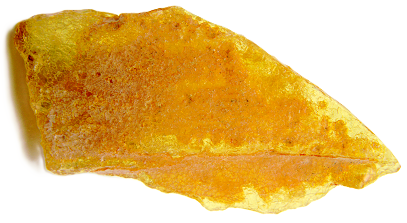
Copal derives its name from the Nahuatl word “copalli,” meaning resin or incense, reflecting its traditional use in ceremonies and rituals. Often called Young Amber, Copal is a precursor to fossilised Amber, sharing similar properties but in an earlier stage of formation. Some cultures refer to it as Sacred Copal, recognising its spiritual significance in purification and transformation practices.
Composition, Physical Characteristics, and Varieties
Copal is a natural tree resin, primarily composed of terpenes and organic compounds. Unlike Amber, which has undergone fossilisation, Copal remains semi-hardened and exhibits a range of translucency from pale yellow to rich golden hues. It often contains plant material or insect inclusions, adding to its mystique.
Varieties of Copal include:
- Gold Copal – warm golden tones, commonly used in incense.
- Black Copal – deep, smoky colour, associated with protection rituals.
- White Copal – paler shade, revered for its cleansing properties.
Geographical Locations Where It Is Found
Copal sources exist across Central and South America, Africa, and Indonesia. In Mexico and Guatemala, indigenous communities harvest Copal from sacred trees, using it in rituals and ceremonies.
Archaeological and Significant Finds with Historical and Current Usage
Ancient Maya, Aztec, and Inca civilisations considered Copal a divine offering, burning it in temples to honour deities. In Africa, shamans used it in healing and protective rituals. Today, Copal remains essential in spiritual practices, energy cleansing, and incense blends, cherished for its sacred and aromatic qualities.
Interesting Facts
- Copal is an early stage of Amber, sharing similar botanical origins but lacking full fossilisation.
- Indigenous cultures burn Copal in ceremonial offerings, believing it carries prayers to higher realms.
- Some specimens contain prehistoric insect inclusions, making them valuable for scientific study.
Folklore, Superstition, Legends, and Tales
Copal has long been revered as a bridge between worlds, carrying intentions and prayers to spiritual entities. Ancient traditions believe its smoke wards off negativity, creating a purified space for ritual work. Shamans use Copal to guide souls on their journey, ensuring safe passage through the unseen realms.
Mystical Healing Properties, Astrology, and Zodiac Associations
Copal resonates with cleansing, transformation, and higher awareness, helping remove stagnant energy and enhance spiritual clarity. Astrologically, it aligns with Leo, Sagittarius, and Scorpio, complementing their dynamic and mystical nature:
- Leo – strengthens personal empowerment and leadership.
- Sagittarius – enhances wisdom and spiritual exploration.
- Scorpio – deepens transformation and ritual practices.
Chakra System Connections
Copal primarily connects with the Solar Plexus Chakra, aiding personal transformation and confidence. It also resonates with the Crown Chakra, supporting higher consciousness and spiritual enlightenment.
Use as a Birthstone and for a Wedding Anniversary
Copal makes a meaningful alternative birthstone for Leo and Sagittarius, encouraging clarity and strength. It is sometimes given for a 34th wedding anniversary, symbolising purification and wisdom gained through experience.
Crystals That Work Well with Copal and Those to Avoid
- Best Pairings:
- Amber – deepens ancestral connections and stability.
- Selenite – enhances purification and energy cleansing.
- Carnelian – boosts creativity and motivation.
- Crystals to Avoid:
- Obsidian – its intense grounding energy may disrupt Copal’s uplifting properties.
- Blue Kyanite – its tranquil vibrations may soften Copal’s transformative influence.
